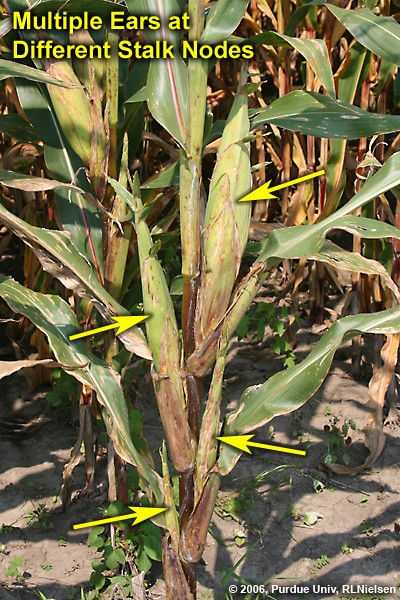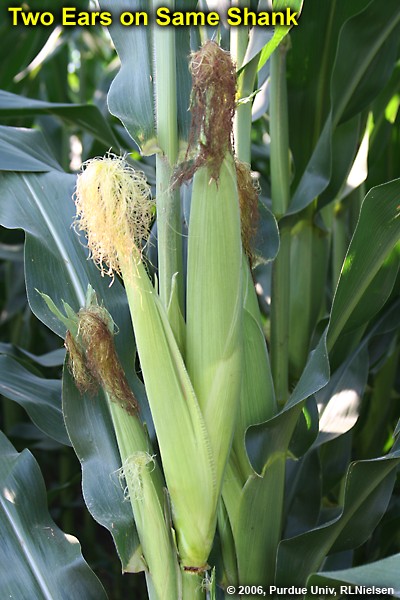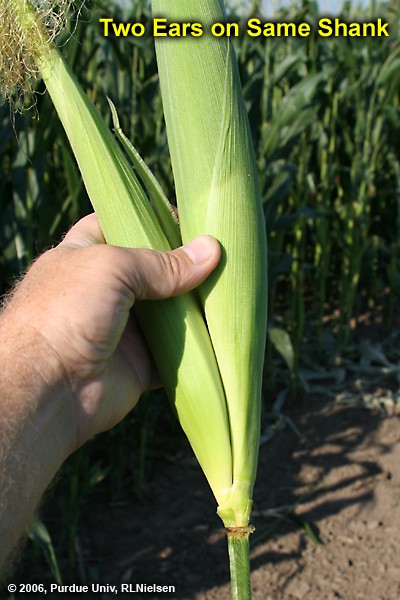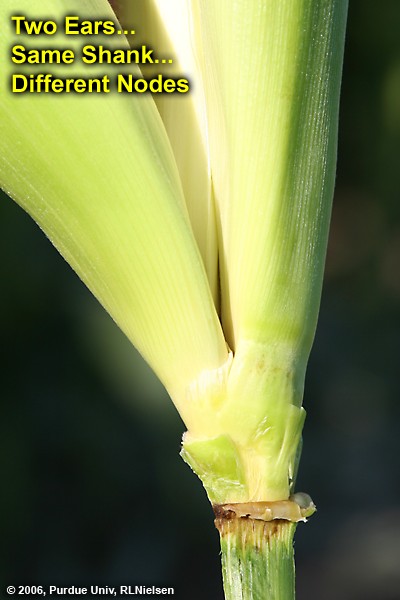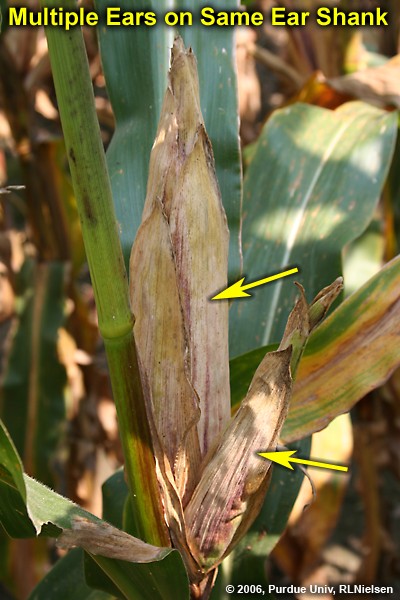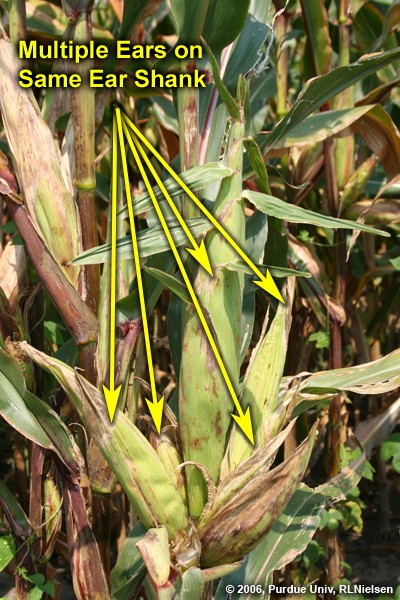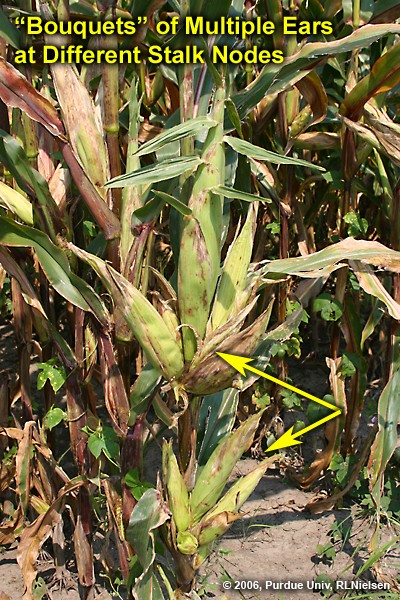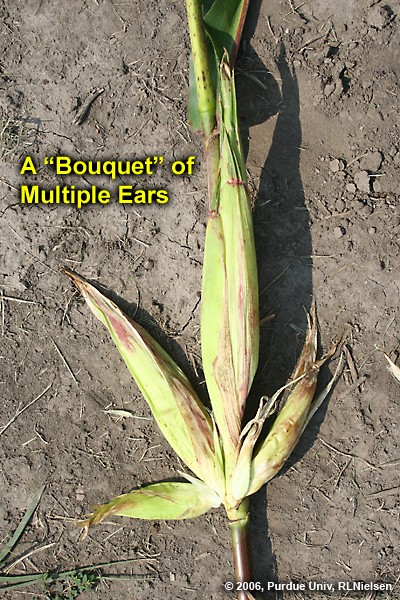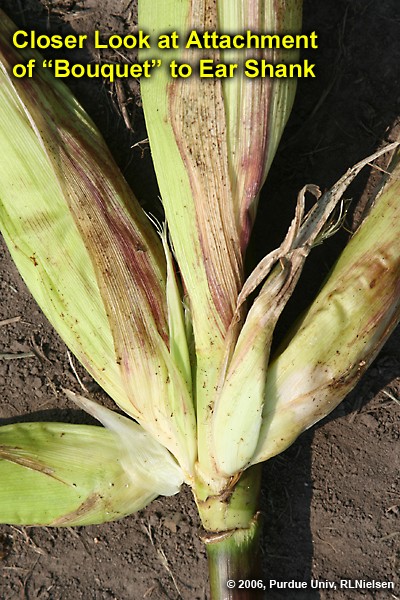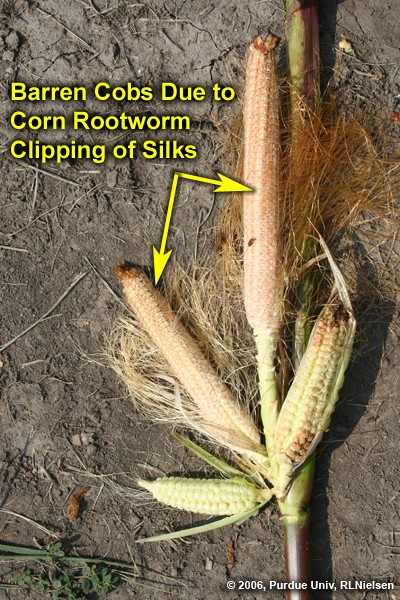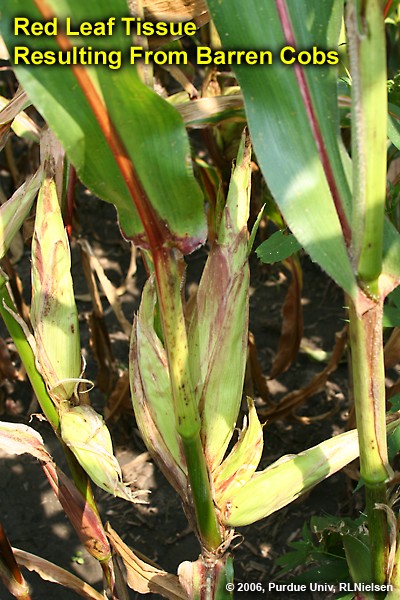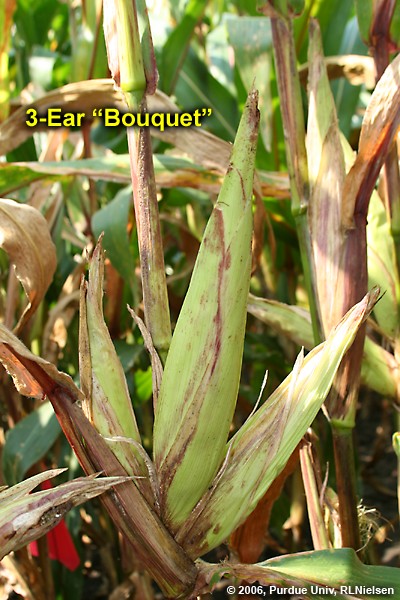(orig. published Sep 2006, updated Feb 2025)
URL: http://www.kingcorn.org/news/articles.06/Bouquets-0912.html
Not All "Bouquets" Are Beautiful
R.L. (Bob) Nielsen
Professor Emeritus
Agronomy Dept., Purdue Univ.
West Lafayette, IN 47907-2054
Email address: rnielsen at purdue.edu
Twitter: @PurdueCornGuy
Multiple ears on a single plant are not unusual, but the multiple ears usually develop separately from individual stalk nodes (Fig. 1). The oddity/problem being reported this season is one of multiple ears that originate from individual nodes on a single ear shank (Fig's 2, 6).
First Comment: The fact that multiple ears can develop from a single ear shank in and of itself is not unusual (Nielsen, 2014). The ear shank is essentially a replica of the main stalk of the plant. The ear shank develops leaves like the main stalk. These husk leaves originate from individual nodes of the shank like the main leaves develop from individual stalk nodes. The ear shank terminates with a reproductive organ (the female ear) somewhat akin to the main stalk terminating with a reproductive organ (the male tassel). Additional ear shoots can develop from individual nodes of the ear shank (Fig. 4) like additional ear shoots that develop from individual nodes of the main stalk (Fig. 1).
Second Comment: Normally the ear shank does not initiate these secondary ears or initiates these secondary ears but they soon cease development due to apical dominance from the apical ear (Fig. 5).
Third Comment: What was unusual in 2006 was the occurrence of a "bouquet" effect of 3 to 5 ears (or more) developing from an individual ear shank (Fig. 6). Furthermore, and particularly disconcerting to growers, in many cases none of the multiple ears pollinated successfully or set kernels. In some cases, all of the multiple cobs were severely stunted as well. Where kernel set was nonexistent or very limited, the affected plants eventually turned red/purple in response to excessive photosynthate concentration in the leaves and stalk tissues (Nielsen, 2022). In some situations, as much as 30 to 50% of the plants in an area of a field were affected. Obviously, the yield loss in these severe situations was dramatic.
Fourth Comment: The cause of this "bouquet" effect of multiple ears is not known. Some of us agronomists tried to compile background information from affected fields, but the number of affected fields was admittedly (and thankfully) few. To my knowledge, there was no single common thread identified among the affected fields. What I suspect is that a) some hybrids are genetically prone to developing multiple ears on a single ear shank and b) more than one external "trigger" enables the development of multiple ears to occur on these hybrids. Identifying the "trigger(s)" is the challenge.
For example, the "bouquet" effect showed up in one of three hybrids I was using in 2006 in my planting date demo plots at the Crop Diagnostic Training Center near West Lafayette (i.e., a hybrid apparently prone to multiple ears). Furthermore, the "bouquet" effect was more prevalent and severe in later planted plots where silk clipping by rootworm beetles prevented kernel set on the primary ear (i.e., possibly minimizing or negating apical dominance against secondary ears). That suggested that extremely poor kernel set on the primary ear "releases" the hormonal apical dominance exerted on the lower nodes of the ear shank, thus allowing the initiation/development of secondary ears on the same ear shank or lower stalk nodes.
Related References
Elmore, Roger and Lori Abendroth. 2006. Multiple ears per node: Iowa 2006 situation and hypothesis. ICM News. Iowa State Univ. https://crops.extension.iastate.edu/encyclopedia/multiple-ears-node-iowa-2006-situation-hypothesis [accessed Feb 2025].
Jeschke, Mark. 2021. Why Do Corn Plants Develop Multiple Ears on the Same Shank? Pioneer/Corteva. https://www.pioneer.com/us/agronomy/multiple-ears.html [accessed Feb 2025].
Nielsen, R.L. (Bob). 1999. What A MESS! (aka Multiple Ears on a Single Ear Shank) Corny News Network, Purdue Univ. http://www.kingcorn.org/news/articles.99/990823b.html [accessed Feb 2025].
Nielsen, R.L. (Bob). 2014. Multiple Ears of Corn on the Same Shank. Corny News Network, Purdue Univ. http://www.kingcorn.org/news/timeless/MessyEars.html [accessed Feb 2025].
Nielsen, R.L. (Bob). 2022. Prevalent Purple Plants Perennially Puzzle Producers. Corny News Network, Purdue Univ. http://www.kingcorn.org/news/timeless/PurpleCorn.html [accessed Feb 2025].
Click image to view larger version in a popup window. Left or right arrow on your keypad will cycle through the popup images.
